

The Difference Between Knowledge and Experience. Steal Like an Artist and Relax: Original Is Relative. What a load of utter crap.

Sure, I understand that matter cannot be created or destroyed, but are you really suggesting that what you're referring to here doesn't extend to ideas? Taking inspiration from something doesn't necessarily mean you're riffing on it, remixing it or mashing it up. Great art, great science and even great philosophy always - ALWAYS - makes something that is greater than the sum of its parts. Are you suggesting that a new word can't be original just because it's made of letters that already exist? So how about running an article on this: "EVERYTHING is original. Quote me on that. It's certainly no more bollocks than the article above (and the content that it's a remix of). ...And I didn't need a bible to illustrate my point.
Nine of the Best Ways to Boost Creative Thinking. Why we have our best ideas in the shower: The science of creativity. 8.2K Flares Filament.io 8.2K Flares × “I’m not really a creative person”, always struck me as an odd sentence.
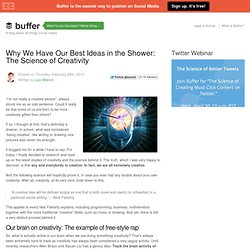
Could it really be that some of us are born to be more creatively gifted than others? If so, I thought at first, that’s definitely a downer. In school, what was considered “being creative”, like writing or drawing nice pictures was never my strength. It bugged me for a while I have to say. And the following science will hopefully prove it, in case you ever had any doubts about your own creativity. “A creative idea will be defined simply as one that is both novel and useful (or influential) in a particular social setting.” – Alice Flaherty This applies to every field Flaherty explains, including programming, business, mathematics together with the more traditional “creative” fields, such as music or drawing.
The Difference Between Knowledge and Experience. Why Creativity Necessitates Eclecticism: Nick Cave’s Influences. How Einstein Thought: Why “Combinatory Play” Is the Secret of Genius. Austin Kleon on Cultivating Creativity in the Digital Age. By Maria Popova The genealogy of ideas, why everything is a remix, or what T.S.
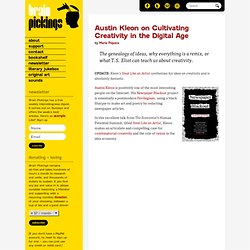
Eliot can teach us about creativity. UPDATE: Kleon’s Steal Like an Artist synthesizes his ideas on creativity and is absolutely fantastic. Austin Kleon is positively one of the most interesting people on the Internet. His Newspaper Blackout project is essentially a postmodern florilegium, using a black Sharpie to make art and poetry by redacting newspaper articles. In this excellent talk from The Economist‘s Human Potential Summit, titled Steal Like an Artist, Kleon makes an articulate and compelling case for combinatorial creativity and the role of remix in the idea economy.
Networked Knowledge and Combinatorial Creativity. By Maria Popova Why creativity is like LEGO, or what Richard Dawkins has to do with Susan Sontag and Gandhi.
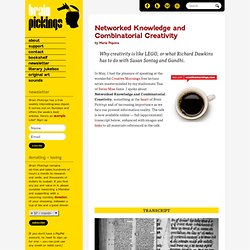
In May, I had the pleasure of speaking at the wonderful Creative Mornings free lecture series masterminded by my studiomate Tina of Swiss Miss fame. I spoke about Networked Knowledge and Combinatorial Creativity, something at the heart of Brain Pickings and of increasing importance as we face our present information reality. The talk is now available online — full (approximate) transcript below, enhanced with images and links to all materials referenced in the talk. These are pages from the most famous florilegium, completed by Thomas of Ireland in the 14th century.
In talking about these medieval manuscripts, Adam Gopnik writes in The New Yorker: Einstein on Kindness, Our Shared Existence, and Life’s Highest Ideals. How Creativity Works. By Maria Popova Inside the ‘seething cauldron of ideas,’ or what Bob Dylan has to do with the value of the synthesizer mind.
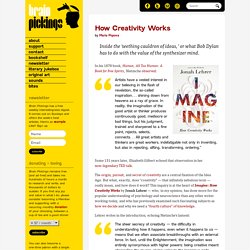
In his 1878 book, Human, All Too Human: A Book for Free Spirits, Nietzsche observed: Artists have a vested interest in our believing in the flash of revelation, the so-called inspiration… shining down from heavens as a ray of grace. A 5-Step Technique for Producing Ideas circa 1939. How Creativity in Humor, Art, and Science Works: Arthur Koestler’s Theory of Bisociation. By Maria Popova “The discoveries of yesterday are the truisms of tomorrow, because we can add to our knowledge but cannot subtract from it.”
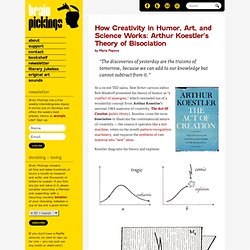
At a recent TED salon, New Yorker cartoon editor Bob Mankoff presented his theory of humor as “a conflict of synergies,” which reminded me of a wonderful concept from Arthur Koestler’s seminal 1964 anatomy of creativity, The Act Of Creation (public library). Koestler coins the term bisociation to illustrate the combinatorial nature of creativity — the reason it operates like a slot machine, relies on the mind’s pattern-recognition machinery, and requires the synthesis of raw material into “new” ideas. Koestler diagrams his theory and explains: The pattern underlying [the creative act] is the perceiving of a situation or idea, L, in two self-consistent but habitually incompatible frames of reference, M1 and M2. Koestler goes on to discuss the forms this creative instability takes in humor, art, science. River delta image: “The Lagoon” by Jamie Meunier.